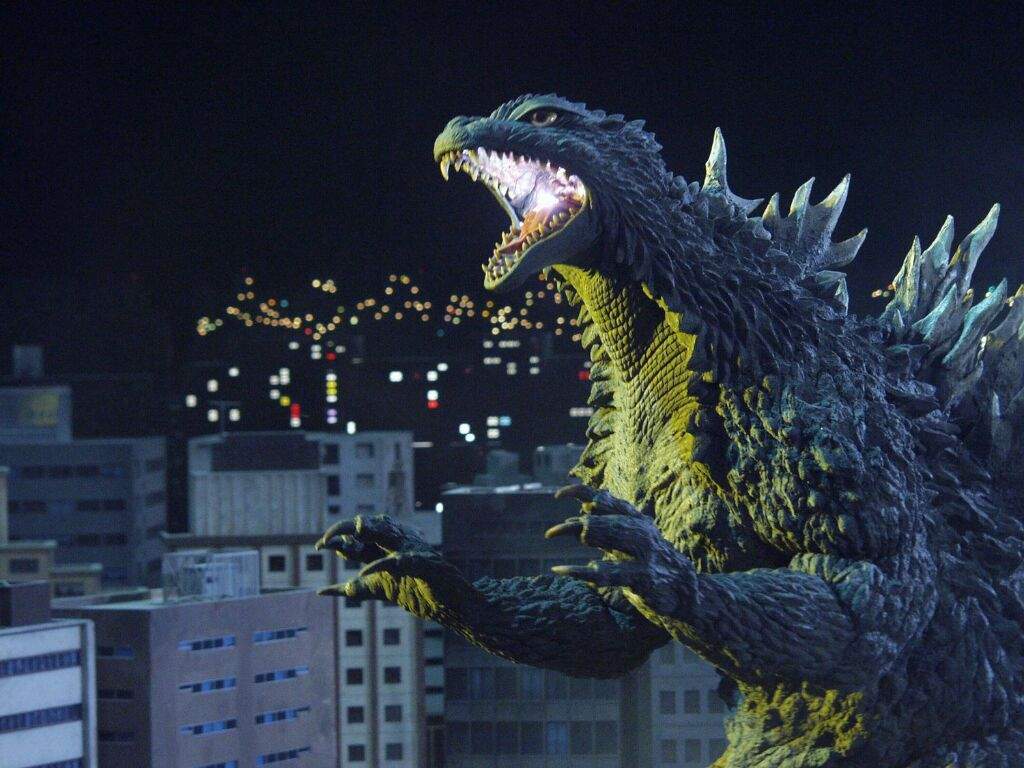

BIO:
During the Paleogene, Acrocanthosaurus evolved into Gojirasaurus, a deadly ocean predator that arose after many generations adapting to their new marine environment. Usually on the hunt near the ocean’s surface, Acrocanthosaurus’ spines elongated to form sails to better navigate the world’s oceans. They developed extra sets of dorsal fins making them faster and more agile swimmers, and eventually, grew bones that protruded through their sail-like spines as defenses against rivals.
Gojirasaurs also began swallowing radioactive rocks to aid in digestion and to fuel their colossal bodies. After meals, they would release excess radioactive heat from their dorsal fins to cool off. The nuclear heat even allowed the giant theropods to traverse environments with subfreezing temperatures.
Gojirasaurus, however, weren’t the only giant fauna around in the Paleogene. Although Gojirasaurus were Earth’s most dominant predators, they were routinely challenged by Angilasaurus, Europe’s armored, terrestrial rulers. Their epic battles resulted in further adaptations to confront one another. Paleontologists believe that their eons-long rivalry resulted in Gojirasaurus utilizing its hands for combat to potentially flip and immobilize Angilasaurus.
Millions of years later in the Neogene era, Gojirasaurus evolved into their current and most formidable form, Godzilla. After generations of swallowing radioactive rocks, Godzillas’ stomach changed chemically and physiologically, and thus now able to draw from the combustion in its stomach to produce its signature atomic breath. Unlike its earlier form, Gojirasaurus, Godzilla no longer had to release radioactive heat from its fins, now it could also fire it from its mouth for offense, creating an epic and awe-inspiring explosion. However, Godzilla only made use of this skill sparingly to avoid internal burns, making its true strength a mystery.
Godzilla’s scales also evolved to be remarkably resilient and dense due to the species’ history of traversing the globe and fighting various - if not all - kaiju. This fact highlights the mystery of why Godzilla is the last of his kind. Paleontologists so far hypothesize some sort of cataclysmic event happened thousands of years ago, devastating the Godzilla population as well as others. Regardless of the circumstances, the supposed last Godzilla still reigns as top predator among Earth’s kaiju, leading to his famous title as “King of the Monsters”.
Spanish: Biografía de Godzilla
Durante el Paleógeno, el Acrocanthosaurus evolucionó hasta convertirse
en el Gojirasaurus, un mortífero depredador oceánico que surgió tras
muchas generaciones adaptándose a su nuevo entorno marino. Normalmente a
la caza cerca de la superficie del océano, las espinas de los
Acrocanthosaurus se alargaron para formar velas y navegar mejor por los
océanos del mundo. Desarrollaron conjuntos adicionales de aletas
dorsales que los hacían nadadores más rápidos y ágiles, y finalmente,
les crecieron huesos que sobresalían a través de sus espinas en forma de
vela como defensas contra sus rivales.
Los Gojirasaurios también empezaron a tragar rocas radiactivas para
facilitar la digestión y alimentar sus colosales cuerpos. Después de
comer, liberaban el exceso de calor radiactivo de sus aletas dorsales
para refrescarse. El calor nuclear permitía incluso a los terópodos
gigantes atravesar entornos con temperaturas bajo cero.
Sin embargo, los Gojirasaurus no eran la única fauna gigante del
Paleógeno. Aunque los Gojirasaurus eran los depredadores más dominantes
de la tierra, se veían desafiados a menudo por los Angilasaurus, los
gobernantes terrestres acorazados de Europa. Sus épicas batallas dieron
lugar a nuevas adaptaciones para enfrentarse entre sí. Los paleontólogos
creen que su rivalidad, que duró un largo periodo de tiempo, dio lugar a
que el Gojirasaurus utilizara sus manos para el combate con el fin de
voltear e inmovilizar al Angilasaurus.
Millones de años más tarde, en el Neógeno, el Gojirasaurus
evolucionó a su forma actual y más formidable, la cual es Godzilla. Tras
generaciones de tragar rocas radiactivas, el estómago de Godzilla
cambió química y fisiológicamente, por lo que ahora es capaz de
aprovechar la combustión de su estómago para producir su característico
aliento atómico. A diferencia de su forma anterior, el Gojirasaurus,
Godzilla ya no tenía que liberar calor radiactivo de sus aletas, ahora
también podía dispararlo desde su boca para ofender, creando una
explosión épica e impresionante. Sin embargo, Godzilla sólo utilizaba
esta habilidad con moderación para evitar quemaduras internas, por lo
que su verdadera fuerza y poder es un misterio.
Las escamas de Godzilla también evolucionaron para ser
notablemente resistentes y densas debido a la historia de la especie de
atravesar el globo y luchar contra varios -si no todo- kaiju. Este hecho
pone de manifiesto el misterio de por qué Godzilla es el último de su
especie. Hasta ahora, los paleontólogos plantean la hipótesis de que
algún tipo de cataclismo ocurrió hace miles de años, devastando a la
población de Godzilla y a otras. Independientemente de las
circunstancias, el supuesto último Godzilla sigue reinando como máximo
depredador entre los kaiju de la tierra, lo que le ha llevado a su
famoso título de "Rey de los Monstruos".
Japanese:
ゴジラ伝記:
古第三紀、アクロカントサウルスは、何世代も経て、新しい海洋環境に適応する恐ろしい海洋捕食者ゴジラサウルスに進化した。普段は海面近くで狩りをしているアクロカントサウルスは、世界中の海をより上手く航海するため、背骨を帆の形となるように、引き延ばした。さらには、背びれを発達させ、より速く、より機敏に泳ぐようになり、やがて帆のような背中から骨が突き出るようになり、敵から身を守るようになったのである。
また、ゴジラザウルスは、消化を助け、その巨体のエネルギー補給のため、放射性岩石を飲み込むようになった。食後は背びれから余分な放射熱を放出し、体を冷やした。この放射熱のおかげで、巨大な獣脚類は氷点下の環境でも移動することができたのだ。
しかし、古第三紀に生息していた巨大生物はゴジラザウルスだけではなかった。ゴジラザウルスは地球上で最も優勢な捕食者であったが、欧州の鎧をまとった地上の支配者であるアンジラサウルスに絶えず脅かされていたのである。彼らの壮絶な戦いは、互いに対抗するためにさらなる進化をもたらした。その結果、古生物学者によると、ゴジラサウルスは両手を戦闘に使用するようになり、アンジラサウルスを投げ飛ばし、動けなくすることができるようになったのである。
数百万年後の新第三紀に、ゴジラザウルスは現在の最も恐ろしい姿であるゴジラに進化した。何世代にもわたって放射性物質を含んだ岩石を飲み込んできたゴジラの胃は、化学的、生理的に変化し、その結果、胃の中の燃焼を利用して、特有のアトミックブレスを作り出すことができるようになったのである。以前のゴジラザウルスとは異なり、ヒレから放射熱を放出する必要がなくなり、口から放射熱を発射して攻撃できるようになり、大規模で驚異的な爆発を起こすことができるようになった。しかし、この能力は体内の火傷を避けるために控えめにしか使わず、その実力は謎に包まれている。
また、ゴジラのウロコは、地球上を渡り歩き、様々な怪獣と戦う中で、著しく弾力的で頑丈なものに進化した。この事実が、なぜゴジラが最後の種なのかという謎を解き明かしている。古生物学者のこれまでの仮説では、数千年前になんらかの天変地異が起こり、ゴジラだけでなく他種も壊滅的な打撃を受けたとされている。いずれにしても、最後の種とされるゴジラは地球上の怪獣の頂点に君臨しており、「怪獣王」の称号を持つにふさわしい。
No comments:
Post a Comment